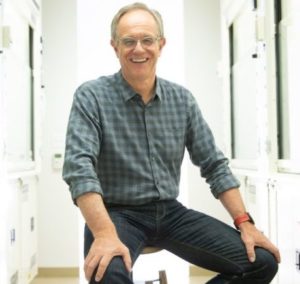by Buck Institute
April 10, 2020 . BLOG
COVID-19 and the Aging Immune System
 By Eric Verdin, President and CEO of the Buck Institute
By Eric Verdin, President and CEO of the Buck Institute
Immunity is on everyone’s mind as we work to protect ourselves and each other from SARS-Cov2, the virus responsible for COVID-19 (note: this term refers to the disease caused by SARS-Cov2). One reason this virus has spread so rapidly is its novelty. The virus is totally new to our immune systems, and our bodies are not prepared to fight it off. A particular feature of this virus is how much more dangerous it is for older adults than for other age groups. Data about COVID-19 infections, hospitalizations, and deaths clearly indicate a much greater risk for older adults. A recent article from STAT News highlights some of the data from China: more than 18% of people in their 80s require hospitalization from COVID-19, whereas only 3.4% of people in their 30s do. As someone who studies how the immune system changes with aging, I’m immediately curious about how known changes to the immune system with age can be contributing to the severity of the disease in older adults - and how we can fix it. The Buck is already involved in an international effort to narrow down a candidate list of 69 drugs that can potentially be treatments for COVID-19. In this blog I want to provide a general overview of how the immune system ages to give some insight into why COVID-19 might be so much more serious to older adults.
Immunity and Aging
Our immune system has evolved to protect the body against pathogens, such as bacteria and viruses. It operates on two levels: the innate response and the adaptive response. The innate immune system has a generic response to anything it recognizes as “foreign”. One of the main features of the innate response is inflammation, a cellular response that alerts the rest of the system that there’s a problem. The adaptive immune system is a slower response that is tailored to the specific pathogens the system encounters. Vaccines typically work by activating the adaptive immune system and “training” the body to recognize a specific virus, so the body can easily fight it off if it ever encounters the real thing. This is also the reason we become immune to some viruses after having them once; the next time our system encounters the virus it is able to quickly tailor an attack to fend off the invasion.
I have spent much of my career investigating how both the adaptive and innate immune systems change with age. The aging human immune system is characterized by two key changes, an increase in innate immune responses or chronic inflammation (also referred to as “inflammaging”) and a decrease in adaptive responses (referred to as “immunosescence”). A decrease in adaptive responses means that cells that create and hold memories of pathogens die off without dividing. This limits our body’s ability to respond to new infections like this novel coronavirus. This also limits our ability to respond to vaccine as we age.
An increase in innate immunity, chronic inflammation or inflammaging is characteristic of aging and of the chronic diseases of aging. This leads to damage to inflamed tissues and thus decreasing their resilience to infection. It appears that a key factor determining a poor prognosis during COVID-19 is a hyperactive innate immune system, thereby possibly explaining the increased complications in older adults.
Many labs, including mine, are dedicated to finding ways to help the immune system maintain its function as it ages. In my lab, we are particularly interested in how a key metabolite called NAD+ can stimulate an aging immune system. Developing biomarkers that can spot potential trouble for the immune system and creating therapeutics that can prevent or reverse damage are a really exciting prospect for improving health and resilience in older adults.
There are years of research ahead to fully understand how COVID-19 interacts with an aging immune system, but the evidence already points to a role for both immunosenescence and inflammaging in the increased risk older adults are experiencing. It is also becoming clear that it is not only one’s age but also the presence of pre-existing chronic conditions that play a role in the severity of COVID-19. Healthy older adults are much less likely to require hospitalization than those who are already battling one more age-related disease. In an upcoming blog I hope to share some tips and resources for maintaining or even improving your health and immunity during this difficult time.

SHARE